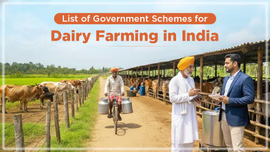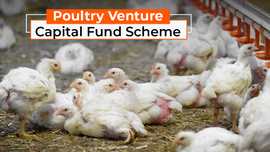Government Schemes to Promote Animal Husbandry in India

Table of Contents
- Introduction
- Rashtriya Gokul Mission
- National Livestock Mission
- Animal Husbandry Infrastructure Development Fund
- National Programme for Dairy Development
- Dairy Infrastructure Development Fund
- National Animal Disease Control Programme
- Livestock Health and Disease Control
- Supporting Dairy Cooperatives & Farmer Producer Organizations
- Conclusion
Introduction
Animal Husbandry is the scientific management of livestock, birds, fish, and insects for food and non-food purposes. It is a critical subsector of Indian agriculture as it is a means of livelihood for small and marginal farmers in rural India.
Besides, it is an integral part of the rural economy as it supplies energy for crop production in the form of organic manure and draught power. It also plays an important role in diversifying Indian agriculture.
Animal Husbandry in India is plagued by various issues, such as low productivity, the use of obsolete technologies, a lack of entrepreneurship and trained experts in veterinary sciences, and the dominance of low-quality indigenous breeds.
To address these issues, the Government of India has introduced a series of schemes to promote and improve the livestock sector in India.
Rashtriya Gokul Mission (RGM)
Cattle farming is widespread in India due to the presence of many indigenous cattle breeds. In December 2014, the Rashtriya Gokul Mission (RGM) was launched to promote the conservation and development of indigenous bovine breeds in the country.
Some of the key features of the scheme are:
- The scheme has two components – the National Mission for Bovine Productivity and the National Program for Bovine Breeding.
- It seeks to increase milk production and enhance the productivity of cattle.
- To increase the stock of indigenous bovines, the scheme seeks to undertake breed improvement programmes.
- The scheme will be implemented on a 100% grants-in-aid basis.
- It seeks to establish 21 Gokul Grams to develop indigenous breeds.
National Livestock Mission (NLM)
The livestock sector is an integral part of Animal Husbandry in India. To generate employment and bring livestock rearing to the organised sector, the Indian government launched the National Livestock Mission (NLM) in 2014-15.
The NLM scheme aims to develop entrepreneurship in the piggery, goat, sheep, cattle, and fodder sectors by providing a 50% capital subsidy.
The scheme has three sub-missions. These are focused on
- Development of breeds in poultry and livestock
- Development of feed and fodder
- Promoting R&D, extension services and innovation.
Animal Husbandry Infrastructure Development Fund (AHIDF)
The Animal Husbandry Infrastructure Development Fund (AHIDF) was set up under the Atma Nirbhar Bharat Abhiyan. It seeks to establish infrastructure for dairy processing and animal feed.
The key features of the AHIDF are:
- It was set up with a corpus of INR 15,000 crore.
- It seeks to increase the meat and milk processing capacity.
- It also aims to provide greater access to organised markets for unorganised meat and milk producers.
- It will help better price realisation for the producer and better quality for the consumers.
- To increase the share of meat and milk in total exports.
National Programme for Dairy Development (NPDD)
India is the largest producer and consumer of milk. To further increase milk production and enhance milk quality, the NPDD scheme was launched in February 2014. The scheme also intends to increase the share of organised milk procurement.
NPDD has two components. These are:
- Build Infrastructure for Milk Testing: This project will be implemented over five years, from 2021-22 to 2025-26.
- Create Infrastructure for Market Linkages: This project will be implemented with aid from the Japan International Cooperation Agency (JICA) from 2021-22 to 2025-26.
Dairy Infrastructure Development Fund (DIDF)
The Dairy Processing and Infrastructure Development Fund (DIDF) was launched in 2017-18. The scheme was set up with a corpus of INR 8,004 crore from the National Bank for Agriculture and Rural Development (NABARD).
The objective of the DIDF Scheme is to modernise the milk processing plants and create additional infrastructure for processing more milk.
The scheme aims to provide a 65% subsidy to the capital-stressed milk cooperatives to replace the decades-old chilling and processing plant.
To build an efficient milk procurement system at the village level, the scheme aims to set up chilling and processing infrastructure and install electronic milk adulteration testing equipment.
National Animal Disease Control Programme (NADCP)
The programme was launched in September 2019 to control Foot & Mouth Disease (FMD) and Brucellosis.
It seeks to control livestock diseases by 2025 and eradicate them by 2030. It also aims to vaccinate over 500 million livestock and 36 million bovine female calves. These include:
- Vaccinating 100% cattle, buffalo, sheep, goat, and pig population for FMD and
- Vaccinating 100% bovine female calves of 4-8 months of age for brucellosis.
Livestock Health and Disease Control (LH&DC)
The government launched the Livestock Health and Disease Control (LH&DC) Scheme to improve the overall health of the livestock population. It seeks to improve health through vaccination, diagnostic services, and veterinary care.
The main goals are:
- To eradicate PPR in sheep and goats by 2030, and
- To control Classical Swine Fever by vaccinating the overall pig population.
Supporting Dairy Cooperatives & Farmer Producer Organizations (SDCFPO)
The Supporting Dairy Cooperatives & Farmer Producer Organizations scheme offers working capital loans to the State Cooperatives and Federations.
The objective of this scheme is:
- To make the market access stable for dairy farmers
- To enable State Cooperative Dairy Federations to pay the farmers' dues timely and
- Enable the cooperatives to produce milk at a compensable price for Indian farmers during the flush season.
Conclusion
Promoting animal husbandry is critical for sustaining rural livelihoods, especially the livelihoods of small and marginal farmers. With increasing urbanisation, there has been greater demand for animal by-products like milk and meat. However, the use of obsolete technologies, inferior indigenous breeds, and the prevalence of animal disease have led to low livestock productivity. To tackle these issues, the government launches various schemes specific to animal husbandry from time to time.


Related Blogs












